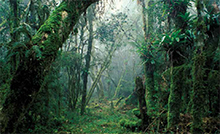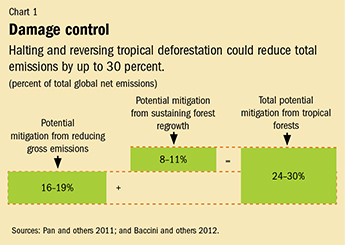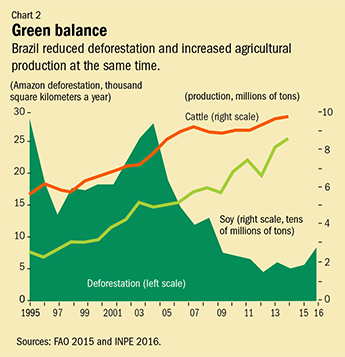Forests for Growth
Finance & Development, March 2017, Vol. 54, No. 1
Frances Seymour and Jonah Busch

Forests are a key asset for climate stability; Brazil has shown protecting them is compatible with development
Tropical forests are places of wonder and beauty in the popular imagination, rich in cultural and biological diversity. Development planners view them more practically—as a source of timber revenue or a land bank for agricultural expansion. But evidence to support a third view is growing rapidly—tropical forests provide essential services that underpin both global climate stability and development goals.
Protecting tropical forests need not be a drag on development, nor a zero-sum trade-off with growth and poverty reduction. Brazil has demonstrated that many of the steps to protect forests are feasible, affordable, “no regrets” measures in tune with more equitable and inclusive growth. Paying developing economies to keep carbon, a major source of global warming, in forests can help overcome incentives for deforestation as usual.
From problem to solution
Climate change is increasingly recognized as a key threat to global economic growth and development, especially to poor households and countries. Exposure to a single major natural disaster such as a hurricane—expected to be more frequent and severe on a warming planet—can knock a country off its economic growth trajectory for decades (Hsiang and Jina 2014).
While everyone knows that burning fossil fuels generates the emissions that cause climate change, deforestation’s role is less well known, and forest protection is an undervalued solution to the problem. Every time an area of forest is cleared or burned, the carbon stored in tree trunks, branches, and leaves is released to the atmosphere. The total contribution of emissions from deforestation exceeds that of the European Union, trailing only China and the United States. Halting tropical deforestation—which currently denudes an area the size of Austria every year—would make a significant dent in global annual emissions.

And because forests recapture carbon as they grow back, they can also mitigate emissions from other sources. In other words, as a natural carbon-capture-and-storage technology, forests can produce net negative emissions, essential to the long-term goal of the 2015 Paris Agreement on mitigating climate change for balance between emissions and removals. Stopping tropical deforestation and allowing damaged forests to recover could deliver reductions of up to 30 percent of current emissions (see Chart 1).
The potential of forests to contribute to mitigation was one reason the Paris Agreement singled out forest conservation as an important opportunity for international cooperation. The Agreement endorses a framework for reducing emissions from deforestation and forest degradation (REDD+): rich countries provide performance-based financing to developing economies in exchange for lower forest-based emissions. Such revenue streams can at least partially compensate forest-rich countries for the forgone benefits of forest exploitation.
And unlike logging and conversion of forests to export-oriented crops—associated with corruption, conflict, and violence in many countries—paying forest-rich countries for successful forest protection can improve forest governance. Results-based financing requires governments to monitor and report progress according to agreed performance indicators, which leads to more transparent and accountable forest management. Further, results-based payments reduce opportunities for corruption.
Invisible contributions
Efforts to reduce deforestation go hand in hand with inclusive growth, and not just through climate protection and better governance. Communities in and around forests collect wood for fuel and charcoal; wild fruits, nuts, mushrooms, insects, and bushmeat for food; and a wide variety of plant materials for medicine and ornamentation. Surveys conducted in 24 countries revealed that on average such forest products constituted 21 percent of household income in these communities (Angelsen and others 2014).
But forests’ economic contributions go far beyond goods to include ecosystem services that are enjoyed locally and on a broader scale. At the scale of farms and villages, forests provide habitat for the birds, bats, and insects that pollinate crops; help stabilize landslide-prone hillsides; and protect coastal communities from storms. Forested watersheds provide freshwater for reservoirs that power hydroelectric dams, support irrigation systems, and maintain municipal water supplies. Recent research suggests that forests play a key role generating the rainfall necessary to sustain agricultural productivity across continents (Lawrence and Vandecar 2015).
Yet forests’ many and varied contributions to achieving the UN Sustainable Development Goals related to hunger and poverty, health, clean energy, clean water, and safety from disasters are mostly invisible to economic decision makers. Typical national statistical surveys and accounts fail to capture forest-based income, and forest-based ecosystem services are effectively assigned a value of zero in economic analyses. Such flawed accounting leads to a bias in favor of clearing forests for other uses.
Yet economic valuation shows that the losses from forest destruction can be substantial. The massive fires in Indonesia in 2015, which burned an area the size of the US state of New Jersey, are a good example. The World Bank estimates losses from those fires at $16 billion, double the potential revenue from planting the burned land with oil palm, whose cultivation has driven much deforestation (World Bank 2015). Putting a price tag on forest services has proven methodologically challenging, but measuring the value of forests for storing carbon is feasible and increasingly accurate.
Feasible and affordable

Brazil has demonstrated that it is possible to decouple agricultural sector growth from forest loss. Over a decade starting in 2004, Brazil reduced the rate of deforestation in the Amazon by some 80 percent. The decline was accompanied by increasing production of soy and beef, which are key drivers of forest clearing (see Chart 2). Brazil’s achievement undermines the frequent assertion by timber and agribusiness interests and their government allies that forest resource exploitation and conversion to other uses are essential to economic growth and the reduction of rural poverty.
How did Brazil do it? Responding to domestic constituencies and negative international attention generated by forest destruction and lawlessness in the Amazon, Brazil marshalled the political will to implement a suite of policies to tame deforestation. These included the establishment of protected areas and indigenous territories, enhanced law enforcement against illegal logging and forest clearing, and restricted credit to high-deforestation municipalities. In addition, under pressure from activists, the soy industry imposed a moratorium on sourcing from recently deforested land. Satellite-based technology for monitoring deforestation was a powerful new tool for effective policy implementation and allowed the authorities to catch unauthorized deforesters in the act. Data from satellites stoked public awareness of the problem and strengthened political will.
The Brazil example also exposed myths about the causes of deforestation. In the Amazon, it was wealthy soy farmers and cattle ranchers who benefited most from deforestation—not the indigenous and other local communities who depended most on forest goods and services for income and well-being. Indeed, across the tropics the presence of indigenous peoples is associated with maintaining forest cover, while the leading driver of tropical forest loss is the commercial-scale conversion of forests to produce globally traded commodities such as palm oil, soy, beef, and pulp and paper. Poorly defined and enforced property rights mean that forest frontiers are often the focus of conflict among competitors for forest resources.
Recognizing the rights of indigenous peoples, strengthening the rule of law, and making land-use planning and management more transparent and accountable are all consistent with more equitable and inclusive growth. And they are affordable: Brazil’s out-of-pocket implementation costs by federal, state, and municipal governments have been estimated at about $2 billion, or less than $4 a ton of avoided carbon dioxide emissions (Fogliano de Souza Cunha and others 2016), far less than the social cost of such emissions or the cost of reducing emissions in other sectors.
Indeed, reducing deforestation is one of the most cost-effective ways to mitigate the emissions that cause climate change, allowing less expensive and more rapid progress toward achieving the goals of the Paris Agreement. And this bargain does not even include the value of the domestic benefits of noncarbon forest services. In Brazil, these benefits include maintaining rainfall that waters southern agricultural breadbaskets, attenuating drought, and reducing sediment behind dams in the world’s second largest producer of hydropower.
The missing piece
The science linking deforestation to climate change, the economics of forest-based mitigation and valuation of forests’ development benefits, and the politics of the Paris Agreement are all aligned to support international cooperation to protect forests in ways compatible with inclusive growth. The missing piece is performance-based financing. Brazil has received more than $1 billion in REDD+ funds, but that is only a fraction of the value of emissions avoided from reduced deforestation. And in the past two years, partly because of austerity-driven cuts in law enforcement budgets, Brazil’s deforestation rate has begun to creep back up.
There are a number of possible sources of REDD+ financing beyond limited aid budgets. The Green Climate Fund is developing a REDD+ funding mechanism. The US state of California and the International Civil Aviation Organization are considering international forest offsets as part of their emission-reduction programs. But these initiatives are still nascent and have not yet translated into tangible incentives for decision makers in forest-rich countries.
With appropriate financial instruments, guaranteed public or private payments for performance in reducing forest-based emissions could transform the future flow of carbon sequestration services into a bankable asset. Repurposing the funds that now subsidize fossil fuels would be a particularly appropriate source of funding for both domestic and international payments. Rather than aid, REDD+ payments should be viewed as purchases of a service that the world needs urgently.
Without a significant increase in the availability of results-based finance, REDD+ will remain a great idea that’s hardly been tried. And that would be a missed opportunity for a win-win for climate and development. ■
Frances Seymour and Jonah Busch are Senior Fellows at the Center for Global Development and the authors of Why Forests? Why Now? The Science, Economics, and Politics of Tropical Forests and Climate Change.
References
Angelsen, Arild, and others. 2014. “Environmental Income and Rural Livelihoods: A Global-Comparative Analysis.” World Development 64: S12–28.
Baccini, A., and others. 2012. “Estimated Carbon Dioxide Emissions from Tropical Deforestation Improved by Carbon-Density Maps,” Nature Climate Change 2 (3): 182–85.
Fogliano de Souza Cunha, Felipe A., and others. 2016. “The Implementation Costs of Forest Conservation Policies in Brazil.” Ecological Economics 130: 209–20.
Food and Agriculture Organization of the United Nations (FAO), Statistics Division, “Production quantities by country,’’ updated 2015, http://faostat3. fao.org/browse/O/*/E
Hsiang, S. M., and A. S. Jina. 2014. “The Causal Effect of Environmental Catastrophe on Long-Run Economic Growth: Evidence from 6,700 Cyclones.” NBER Working Paper 20352, National Bureau of Economic Research, Cambridge, MA.
Lawrence, D., and K. Vandecar. 2015. “Effects of Tropical Deforestation on Climate and Agriculture.” Nature Climate Change 5 (1): 27–36.
National Institute for Space Research (INPE). 2016. “Projeto Prodes: Monitoramento da Floresta Amazônica Brazileria Por Satelite.” http://www.obt.inpe.br/prodes/index.php
Pan, Yude, and others. 2011. “A Large and Persistent Carbon Sink in the World’s Forests.” Science 333 (6045): 988–93.
World Bank. 2015. “Reforming amid Uncertainty.” Indonesia Economic Quarterly (December).


